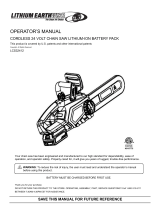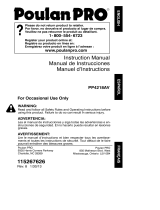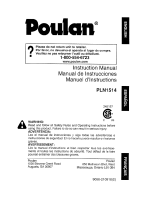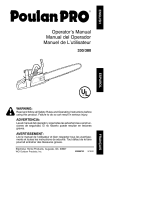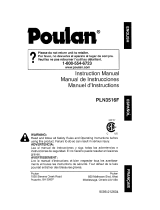
3
S Keep the handles dry and clean and
free from oil and grease.
S Keep oil cap and fasteners sec urely
tightened.
S Nonconformi ng r eplacement compo-
nents or the removal of safety devices
may cause damage to the unit and pos-
sible injur y to the operator or bystand-
ers. Use only Poulan accessories and
repl acement parts as recommended.
Never modif y your saw.
S Maintain chain saw with care.
S Keep unit sharp and clean for better
and safer performance.
S Follow instructions for lubricating and
changing accessories.
S Unplug the chain saw from the power
source when not in use, before servic-
ing, and when changing accessories
and att achments, such as saw chain
and guard.
S Check for damaged parts. Before fur-
ther use of the chain saw, a guard or
other part that i s damaged should be
carefully checked to determine that it will
operate properly and perform its in-
tended functi on. Check for alignment of
moving parts, binding of moving parts,
bre aka ge of part s, mount ing and any
other conditi ons that may aff ect its op-
erati on. A guard or ot her part that is
damaged should be properly repair ed
or replaced by an authorized ser vice
dealerunless otherw ise indicat ed else-
where in the instruct i on manual.
S When not in use, c hain saws should
be s tored in a dry, high or locked-up
place out of the reach of children.
S When s toring saw, unplug and us e a
bar sheath or carrying case.
ELECTRICAL SAFETY
WARNING: Avoid a dangerous en-
vironment . To reduce the risk of electri cal
shock, do not use in rai n, in damp or wet
locati ons, or around swimming pools, hot
tubs, etc. Do not expose to snow, rai n, or
water to avoid the possibility of electrical
shock. Do not handl e exten si o n cord or
plug with wet hands.
S Use a voltage supply as shown on the
nameplate of the unit.
S A void dangerous situ ati ons. Do not use
in the presence of flammable liquids or
gases to avoid creati ng a fire or explo-
sion and/ or causing damage to unit .
S To reduce the risk of electri cal shock,
this appliance has a polar ized plug (one
blade is wider than the other) and will re-
quir e the use of a polar i zed extension
cord. The appliance plug will fit into a po-
lari zed extension cord only one way. If
the plug does not fit fully into the exten-
sion cord, re verse the plug. If the plug
stil l does not fit , obtain a correct polar-
ized extension cord. A polarized exten-
sion cord wil l re quir e the use of a polar-
ized wall outlet. This plug will fit into the
polari zed wall outl et only one way. If
plug does not fit full y into the wall outl et,
reverse the plug. If the plug still does not
fit, contact a qualified electrician to install
the proper wall outlet. Do not change the
equipment plug, extension cord recep-
tacle, or extension cord plug in any way.
S To reduce risk of electri cal shock, use
extension cords specifi cal l y marked as
suitable for outdoor appliances. The
electr i cal rating of the cord must not be
less than the rating of the unit. The cord
must be marked with suf fi x “ W--A” (in
Canada, “ W”). Use a polar ized cord.
Make sure your extension cord is in
good condit ion. Inspect exten sion cord
before use and replace if damaged. Do
not use a damaged cord. Cord insula-
tion must be intact with no cracks or de-
teri or at i on. Plug connector s must be
undamaged. An undersi zed extension
cord will cause a drop in line voltage re-
sulti ng in loss of power and over he ati n g.
If in doubt, use the next heavier gauge.
The lower the gauge number, the heavi-
er the cord (see
SELECT AN EXTENSION
CORD
in the OPERA TION sect i o n). Do
not use multiple cords.
S Do not abuse cord. Never c arry the
unit by the extension cord or yank ex-
tension cord to disconnect unit.
S Secure extension cord to power cord
to prevent disconnection from unit.
S Do not use the unit if the switch does
not turn the unit on and off properly, or
if the lock --out does not work. Repairs
to the switch must be made by an
authorized s ervice dealer.
S Keep extension cord clear of operator
and obstacles at all times. Position
cord so that it will not be caught on
branches. Do not expos e cords to
heat, oil, water, or sharp edges .
S To avoid the possibility of electric shock,
avoid body conta ct with any grounded
conductor, such as metal fences or
pipes.
S Ground Fault Circuit Interrupter
(GFCI) protection s hould be provided
on circuit or outlet to be used. Recep-
tacles are available having built-in
GFCI protection and may be use d for
this measure of safety. Inspect chain
saw cords periodically and if dam-
aged, have repaired by an authorized
service dealer.
















